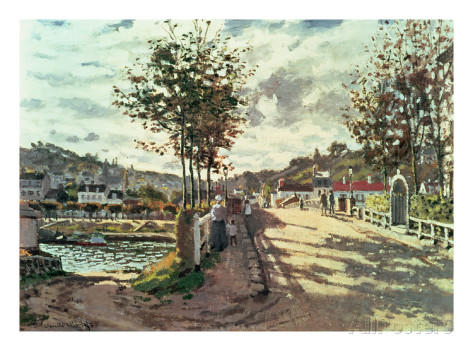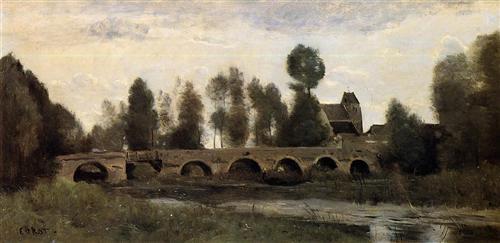This paper is focused on comparison and contrast between the two specially selected paintings. In the paper, the differences and similarities between the two artworks will be identified, discussed, and analyzed. The paintings chosen for this essay are “The Bridge at Grez sur Loing” by Jean Baptiste Camille Corot and “The Seine at Bougival” by Claude Monet. The first painting was created in 1850-60 and the second one in 1869. Both of the paintings belong to Western tradition masters coming from Europe, namely France.
Both artworks are significant works of their creators and are rather well known in the sphere of art, so the two equally meaningful exhibits are compared in this essay. Besides, both works are landscapes and belong to two famous landscapists whose techniques are still admired in the world of nowadays. The first glance at “The Bridge at Grez sur Loing” and “The Seine at Bougival” makes it obvious that even though both works depict similar landscapes, they are incredibly different.
The works by Monet and Corot feature bridges and rivers, trees, and sky. One of the fascinating features of both paintings is light. Corot and Monet were the painters well known for working outdoors, viewing their chosen locations directly, coming there at a selected time of day, and capturing the surrounding areas the way they looked at that very moment.
Even though the work by Corot belongs to the realist movement and Monet is a famous impressionist master, the chosen paintings are equal at capturing the transitional time between day and evening due to the special impression of light being both dim and bright at the same time.


If one puts Corot’s “The Bridge at Grez sur Loing” and Monet’s “The Seine at Bougival” next to each other, the difference between the moods of these two works would be striking. First of all, the artworks employ very different color palettes. “The Bridge at Grez sur Loing” looks much darker, placed next to “The Seine at Bougival” it would seem almost lightless and rather plain as its main colors include shades of dark green, black, grey, and brown. The lightest areas are the sky and its reflection in the water.
They are painted with the use of white and light blue colors. At the same time, put next to “The Bridge at Grez sur Loing,” the work of Monet would look amazingly bright, sunny, and warm. This is understandable because the most popular colors of its palette are very light shades of yellow, white, grey, and blue, together with bright green. Secondly, Monet’s work includes many more details as it features people, various buildings, fences, and complex shadows.
These qualities make it look much more full of life compared to “The Bridge at Grez sur Loing,” which depicts a more simple landscape with a lot of trees and simple lines of the bridge and buildings. Finally, the sky, which plays a very important role in both paintings, is very different. Corot’s sky is almost white. Clouds are barely visible; they are just vague silhouettes. Monet’s sky is full of torn apart clouds lit by the evening sun.
Yet, examined separately from each other, the paintings seem to carry similar emotional contents – the calm and windless landscapes during the transitional period of time between day and evening. Light is the feature that makes each of the paintings stand out. Yet, Monet and Corot use different ways to depict it. Among all of the diverse aspects and parts of Monet’s “The Seine at Bougival,” the feature that communicates the light and mood the most effectively is a shadow, particularly, that of the trees with its lacy structure.
Monet’s impressionist technique with a huge number of tiny strokes merging together into various vague shapes helps the artist create the impression of flickering light. This adds cheerfulness to the overall mood of the painting. The reflection of evening sun in the water turns it golden, while the light falling on the grass makes them transparently bright green. All of these aspects add a lot of warmth to the landscape. Watching it, one cannot even imagine that the day depicted in the artwork is cold or unpleasant.
The work carries a positive mood rather. The great variety of colors adds life to the artwork, even though the general landscape is still, its diverse details bring slight movement to life so that the stillness is not taken away but animated to a certain degree. Corot’s “The Bridge at Grez sur Loing” does not employ any of the techniques mentioned above, yet the light is still perfectly communicated to the viewer. The artist achieved a special light effect by means of creating a strong contrast between the sky and the landscape.
The latter is rather dark, so dark that in certain areas, the colors blend together erasing the details. For example, the areas under the arches of the bridge and between some of the trees are the darkest. They are depicted basically black. At the same time, the sky is painted prevailingly white wit darker spots of light blue. The painting is mesmerizing because it is impossible to tell which time of day is depicted.
The sky is not too cloudy, yet the landscape is dark as if it is evening, yet the presence of light is obvious in the light contour lines of the clouds and in the very light color of the sky, so it still looks like day time. The absence of people and relative homogeneity of the details of the landscape make it very quiet, deserted, and add solemnity to the overall mood of the painting. For creating the perfect balance between the dark and light colors, the artist cleverly added some light spots to the generally dark and dim landscape.
The reflection of the sky in the river serves as a light-colored frame of the bridge and the buildings surrounded by trees. The arches of the bridge are lighted by means of adding some yellow to the overall grey color of the construction. It seems like the setting sun is placed behind the viewer’s back, so its golden light hits the bridge and makes it lighter.
Besides, in order to unify the contrasting sky and landscape, the artists also add some golden tints to the light palette of the sky, as if it reflects the sun. Basically, the sunset which the viewer cannot see directly makes a significant impact on the painting, adding a transparent yet noticeable transitional quality to it.
Historically, both “The Bridge at Grez sur Loing” and “The Seine at Bougival” were created during the same era, the difference between the times when these artworks first saw the world is 10-20 years only. Corot’s creation appeared prior to the work of Monet. It is also important to mention that Corot used to be an artist and a teacher, and his style and techniques had a great influence on the younger artists among whom there was Claude Monet.
Even though Corot’s “The Bridge at Grez sur Loing” is referred to the movement of realism, and Monet was an impressionist, the two works have similarities when it comes to the techniques applied in them. Taking a closer look at “The Bridge at Grez sur Loing” makes it clear that tiny strokes Monet is so famous for were used decades before by Corot. It is especially noticeable in the way the trees and grass were pained. The use of millions of very short strokes to create vague shapes and fussy structure adds an interesting effect to the painting.
The tops of the trees painted in dark colors contrast with the very light sky, and the application of short strokes makes the thinnest tree branches dissolve in the sky, which creates an impression of transparency and multiple layers, making the light deeper, penetrating the texture of the landscape. Corot used this technique is his “Orpheus Leading Eurydice from the Underworld” and “Soleil Couchant.”
Monet’s use of short strokes also helped the master add complexity to work. The addition of tiny touches of white and light yellow make the overall impression of glittering olden light in the painting. This technique is typical for Monet. It is incredibly warm and immediately attracts the viewers. It was used in his other paintings, such as “La Promenade” and “Water Lily Pond.”